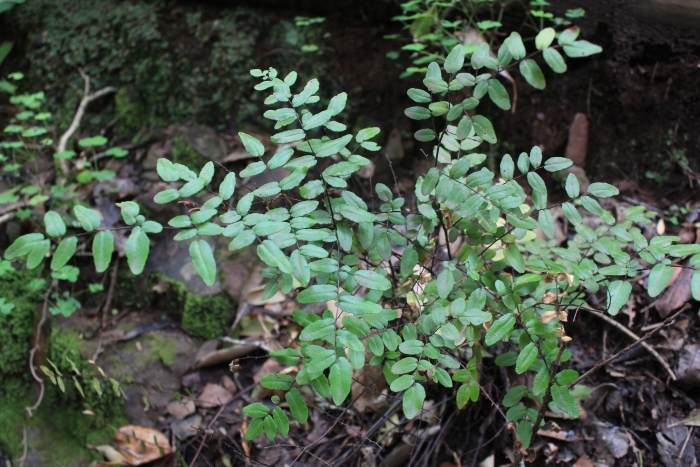Hard Fern
(Pellaea calomelanos)
Hard Fern (Pellaea calomelanos)
/
/

Uwe und Lukas
CC BY-SA 4.0
Image By:
Uwe und Lukas
Recorded By:
Copyright:
CC BY-SA 4.0
Copyright Notice:
Photo by: Uwe und Lukas | License Type: CC BY-SA 4.0 | License URL: https://creativecommons.org/licenses/by-sa/4.0 | Uploader: Uwe und Lukas | Publisher: Wikimedia Commons | Title: Pellaea_calomelanos.JPG | Notes: {{Information |Description= |Source=Own work. |Date=2009-09-27 |Author=Magnus Manske |Permission=Creative Commons Attribution ShareAlike 3.0 |other_versions= }} {{cc-by-sa-3.0}} [[Category:Cambridge University Botanic Garden]] [[Category:Scrophulariacea |





















































Estimated Native Range
Summary
Pellaea calomelanos, commonly known as Hard Fern, is an evergreen fern native to a variety of habitats including rocky slopes, woodlands, and grasslands in Southern and Eastern Africa. It typically grows to a height and width of approximately 0.7 feet (0.2 meters), forming dense clumps of arching fronds. The fronds are blue-green to dark green, adding a unique texture and color to garden settings. Hard Fern produces sori on the underside of the fronds, which are covered by a continuous marginal indusium, a characteristic feature of the genus Pellaea.
Hard Fern is valued for its drought tolerance and its ability to thrive in challenging conditions with minimal care, making it an excellent choice for xeriscaping and rock gardens. It is also used in shaded borders and as ground cover in warm climates. This fern prefers well-drained soil and can tolerate a range of light conditions from full sun to part shade, although in hotter regions, some shade is beneficial to prevent frond scorch. It is not known for significant pest or disease problems, but overwatering should be avoided to prevent root rot.CC BY-SA 4.0
Hard Fern is valued for its drought tolerance and its ability to thrive in challenging conditions with minimal care, making it an excellent choice for xeriscaping and rock gardens. It is also used in shaded borders and as ground cover in warm climates. This fern prefers well-drained soil and can tolerate a range of light conditions from full sun to part shade, although in hotter regions, some shade is beneficial to prevent frond scorch. It is not known for significant pest or disease problems, but overwatering should be avoided to prevent root rot.CC BY-SA 4.0
Plant Description
- Plant Type: Fern
- Height: 0.7-1.8 feet
- Width: 0.272-0.7 feet
- Growth Rate: Slow
- Flower Color: N/A
- Flowering Season: Non-Flowering
- Leaf Retention: Evergreen
Growth Requirements
- Sun: Full Sun, Part Shade
- Water: Low
- Drainage: Fast
Common Uses
Deer Resistant, Low Maintenance, Potted Plant
Natural Habitat
Rocky slopes, woodlands, and grasslands in Southern and Eastern Africa
Other Names
Common Names: Fern
Scientific Names: , Pellaea calomelanos, Pellaea hastata, Pteris calomelanos, Pteris hastata, Hemionitis calomelanos, Allosorus calomelanos, Notholaena calomelanos, Platyloma calomelanon, Platyloma calomelanos
GBIF Accepted Name: Pellaea calomelanos (Sw.) Link